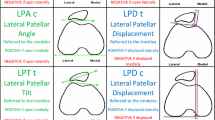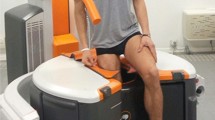Abstract
Purpose
This study aimed to establish the normal values for knee patellofemoral alignment as measured using 3-dimensional computed tomography (3D CT), to standardize the technique, and to show the inter- and intra-observer reliability of this measurement.
Methods
The present study included 62 asymptomatic volunteers (124 knees). 3D CT scanning was performed with each volunteer in the supine position with 15° of knee flexion, and consistent 3D axial images of the patellofemoral joint were obtained with alignment in the desired stereographic baseline direction in anterior–posterior, lateral, and axial rotations. Two independent observers measured patellofemoral alignment parameters, including the sulcus angle, congruence angle, lateral patellofemoral angle, condyle-patellar angle, and lateral trochlear inclination angle.
Results
Based on 3D CT measurement, the mean values of the parameters were 145.9° ± 9.2° for the sulcus angle, 12.6° ± 22.6° for the congruence angle, 9.2° ± 4.6° for the lateral patellofemoral angle, 14.1° ± 6.4° for the condyle-patellar (lateral facets) angle, − 8.5° ± 8.4° for condyle-patellar (patellar axis) angle, and 16.5° ± 6.3° for the lateral trochlear inclination angle. A statistically significant difference was observed between men and women in the sulcus and condyle-patellar (patellar axis) angles (p = 0.045, 0.011, respectively). All parameters showed excellent inter- and intra-observer reliability.
Conclusion
The normal values and ranges for patellofemoral alignment parameters were evaluated using 3D CT. The results of this study provide reference information that may facilitate diagnosis and treatment planning of patellofemoral disorders in skeletally mature non-pathologic patients.
Level of evidence
II







Similar content being viewed by others

References
Alemparte J, Ekdahl M, Burnier L, Hernandez R, Cardemil A, Cielo R et al (2007) Patellofemoral evaluation with radiographs and computed tomography scans in 60 knees of asymptomatic subjects. Arthroscopy 23:170–177
Biedert RM, Gruhl C (1997) Axial computed tomography of the patellofemoral joint with and without quadriceps contraction. Arch Orthop Trauma Surg 116:77–82
Brattstrom H (1970) Patella alta in non-dislocating knee joints. Acta Orthop Scand 41:578–588
Charles MD, Haloman S, Chen L, Ward SR, Fithian D, Afra R (2013) Magnetic resonance imaging-based topographical differences between control and recurrent patellofemoral instability patients. Am J Sports Med 41:374–384
Crema MD, Cortinas LG, Lima GBP, Abdalla RJ, Ingham SJM, Skaf AY (2018) Magnetic resonance imaging-based morphological and alignment assessment of the patellofemoral joint and its relationship to proximal patellar tendinopathy. Skeletal Radiol 47:341–349
Delgado-Martinez AD, Estrada C, Rodriguez-Merchan EC, Atienza M, Ordonez JM (1996) CT scanning of the patellofemoral joint. The quadriceps relaxed or contracted? Int Orthop 20:159–162
Delgado-Martins H (1979) A study of the position of the patella using computerised tomography. J Bone Joint Surg Br 61-B:443–444
Fritz B, Fucentese SF, Zimmermann SM, Tscholl PM, Sutter R, Pfirrmann CWA (2020) 3D-printed anatomic models of the knee for evaluation of patellofemoral dysplasia in comparison to standard radiographs and computed tomography. Eur J Radiol 127:109011
Fulkerson JP (1994) Patellofemoral pain disorders: evaluation and management. J Am Acad Orthop Surg 2:124–132
Ghelman B, Hodge JC (1992) Imaging of the patellofemoral joint. Orthop Clin North Am 23:523–543
Grelsamer RP (2000) Patellar malalignment. J Bone Joint Surg 82-A:1639–1650
Grelsamer RP, Bazos AN, Proctor CS (1993) Radiographic analysis of patellar tilt. J Bone Joint Surg Br 75:822–824
Gulati A, McElrath C, Wadhwa V, Shah JP, Chhabra A (2018) Current clinical, radiological and treatment perspectives of patellofemoral pain syndrome. Br J Radiol 91:20170456
Guzzanti V, Gigante A, Di Lazzaro A, Fabbriciani C (1994) Patellofemoral malalignment in adolescents. Computerized tomographic assessment with or without quadriceps contraction. Am J Sports Med 22:55–60
Inoue M, Shino K, Hirose H, Horibe S, Ono K (1988) Subluxation of the patella. Computed tomography analysis of patellofemoral congruence. J Bone Joint Surg Am 70:1331–1337
Kachooei AR, Rivlin M, Wu F, Faghfouri A, Eberlin KR, Ring D (2015) Intraoperative physical examination for diagnosis of interosseous ligament rupture-cadaveric study. J Hand Surg Am 40:1785-1790 e1781
Koskinen SK, Taimela S, Nelimarkka O, Komu M, Kujala UM (1993) Magnetic resonance imaging of patellofemoral relationships. Skeletal Radiol 22:403–410
Laurin CA, Dussault R, Levesque HP (1979) The tangential x-ray investigation of the patellofemoral joint: X-ray technique, diagnostic criteria and their interpretation. Clin Orthop Relat Res 144:16–26
Laurin CA, Levesque HP, Dussault R, Labelle H, Peides JP (1978) The abnormal lateral patellofemoral angle: a diagnostic roentgenographic sign of recurrent patellar subluxation. J Bone Joint Surg Am 60:55–60
Macri EM, Neogi T, Tolstykh I, Widjajahakim R, Lewis CE, Torner JC et al (2020) Relation of patellofemoral joint alignment, morphology, and radiographic osteoarthritis to frequent anterior knee pain: data from the multicenter osteoarthritis study. Arthritis Care Res (Hoboken) 72:1066–1073
Martinez S, Korobkin M, Fondren FB, Hedlund LW, Goldner JL (1983) Computed tomography of the normal patellofemoral joint. Invest Radiol 18:249–253
Merchant AC, Mercer RL, Jacobsen RH, Cool CR (1974) Roentgenographic analysis of patellofemoral congruence. J Bone Joint Surg Am 56:1391–1396
Moritomo H, Arimitsu S, Kubo N, Masatomi T, Yukioka M (2015) Computed tomography arthrography using a radial plane view for the detection of triangular fibrocartilage complex foveal tears. J Hand Surg Am 40:245–251
Pfirrmann CW, Zanetti M, Romero J, Hodler J (2000) Femoral trochlear dysplasia: MR findings. Radiology 216:858–864
Reikeras O, Hoiseth A (1990) Patellofemoral relationships in normal subjects determined by computed tomography. Skeletal Radiol 19:591–592
Riddle DL, Vossen JA, Hoover KB (2019) Magnetic resonance imaging of patellofemoral osteoarthritis: intertester reliability and associations with knee pain and function. Clin Rheumatol 38:1469–1476
Saffarini M, Muller JH, La Barbera G, Hannink G, Cho KJ, Toanen C et al (2018) Inadequacy of computed tomography for pre-operative planning of patellofemoral arthroplasty. Knee Surg Sports Traumatol Arthrosc 26:1485–1492
Schutzer SF, Ramsby GR, Fulkerson JP (1986) The evaluation of patellofemoral pain using computerized tomography. A preliminary study. Clin Orthop Relat Res 204:286–293
Shen J, Qin L, Yao WW, Li M (2017) The significance of magnetic resonance imaging in severe femoral trochlear dysplasia assessment. Exp Ther Med 14:5438–5444
Shrout PE, Fleiss JL (1979) Intraclass correlations: uses in assessing rater reliability. Psychol Bull 86:420–428
Smith TO, Davies L, Toms AP, Hing CB, Donell ST (2011) The reliability and validity of radiological assessment for patellar instability. A systematic review and meta-analysis. Skeletal Radiol 40:399–414
Tan SHS, Lim BY, Chng KSJ, Doshi C, Wong FKL, Lim AKS et al (2020) The difference between computed tomography and magnetic resonance imaging measurements of tibial tubercle-trochlear groove distance for patients with or without patellofemoral instability: a systematic review and meta-analysis. J Knee Surg 33:768–776
Tomsich DA, Nitz AJ, Threlkeld AJ, Shapiro R (1996) Patellofemoral alignment: reliability. J Orthop Sports Phys Ther 23:200–208
Vahasarja V, Lanning P, Lahde SW (1996) Axial radiography or CT in the measurement of patellofemoral malalignment indices in children and adolescents? Clin Radiol 51:639–643
Funding
None.
Author information
Authors and Affiliations
Contributions
All authors contributed study design, data collecting, analysis, manuscript writing, and revision.
Corresponding author
Ethics declarations
Conflict of interest
The authors declare that they have no conflict of interest.
Ethical approval
This study (IRB number GNAH2017-12-002-0001) was approved by our institutional (Gangneung Asan Hospital) review board.
Informed consent
Voluntary informed consent was required. Plain radiographs of both knees and medical history of all volunteers were checked.
Additional information
Publisher's Note
Springer Nature remains neutral with regard to jurisdictional claims in published maps and institutional affiliations.
Rights and permissions
About this article
Cite this article
Lee, K.W., Seo, DK., Bae, JY. et al. Usefulness of three-dimensional computed tomography for patellofemoral measurement. Knee Surg Sports Traumatol Arthrosc 30, 1423–1429 (2022). https://doi.org/10.1007/s00167-021-06624-6
Received:
Accepted:
Published:
Issue Date:
DOI: https://doi.org/10.1007/s00167-021-06624-6



